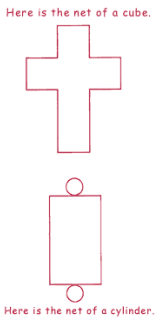|
|
Math For Kids - Squash That BoxEver notice what happens when you flatten cereal boxes, tin cans, or other 3-dimensional shapes for recycling? Or do you ever wonder how they design and make all those interesting containers you find in the department store? Mathematicians call the flat, unfolded designs of 3-dimensional shapes "nets." 
What you'll need:Small cardboard boxes, aluminum cans, and cardboard tubes from toilet paper or paper towelsWhat to do:1) Explain to your child that when we recycle materials, we need to flatten them. Ask him or her why (to save space). Ask your child to imagine what shapes will be created when you flatten the boxes or cans. Some people crush cans, which is not the same as flattening. When you take apart a cylinder, you have two circles for the ends and the flat cylinder makes a rectangle. Cut a cardboard tube lengthwise. What shape do you see (a rectangle)? What will a cereal box look like if you carefully unfold it and cut along the edges?2) Unfold a cardboard box, without showing your child the original box. Ask your child to imagine what the original box looked like. What shape will it be when it is put back together? How will the ends look? 3) Have your child trace all the faces of a box or other 3-dimensional shapes by laying every side and top and bottom on the paper to be traced. Ask the child the names of the drawn 2-dimensional shapes. 4) Have your child study a box. Then see if your child can draw a net (the unfolded version) of the box. Unfold the box to see how closely the drawn net corresponds to the actual net. What would the net of a pyramid look like? What would the net of a cube look like? Parent Tip:Recognizing 2-dimensional shapes in 3-dimensional objects and visualizing shapes are essential skills in fields as varied as architecture, manufacturing, medicine, and design.
| |||
| |
| | |